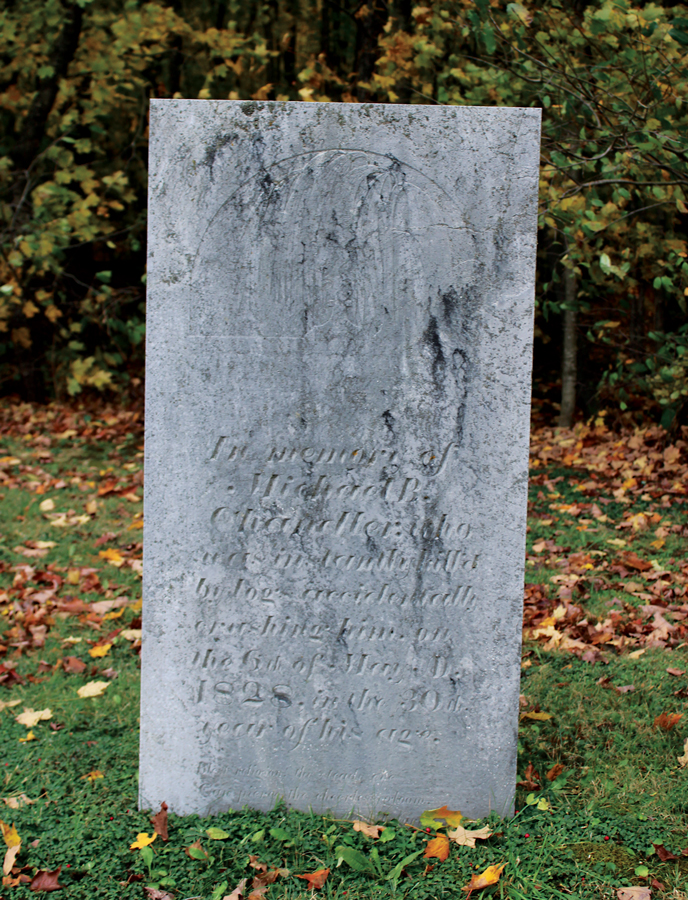Life Cut Short

Un texte de Heather Darch
Paru dans le numéro Printemps/Spring 2025
Publié le : 19 février 2025
Dernière mise à jour : 21 février 2025
Some gravestones stand out as a reminder of the perils our earliest settlers faced. Accidental deaths were frequent.
At the turn of the 19th century, the Eastern Townships attracted hardy young people, initially from the New England colonies, willing to roll up their sleeves and work for a new life. It is unlikely that any of these newcomers anticipated early deaths in their new homeland even though, in that period between the 1790s to the 1830s, death could be “a constant companion.” Children were particularly vulnerable to ailments such as measles, and diseases like tuberculosis could devastate communities. It was the accidental deaths however, that would catch entire communities off-guard. Both children and adults could be cut down in the prime of life.
Accidental deaths were rarely recorded in burial records. They were however, occasionally chronicled on gravestones. The remarkable details carved in stone are there as a reminder about the dangers and fragility of life and to have one’s soul prepared “for man does not know his time.” Ecclesiastes 9:12
The Stanton Cemetery, located in the village of Stanbridge East, Qc. is the final resting place of some of Stanbridge Township’s earliest settlers. It is also where a terrible accident is inscribed on a gravestone. Michael Barnes Chandler (1798–1828) was the son of Joseph Chandler (1765-1830) and Polly Tucker (1767-1829) of Windham County, Connecticut. Around 1800, the Chandlers moved with their growing family to Potton Township, near the present day Mansonville, Qc. The Chandlers purchased land from Colonel Henry Ruiter and began the construction of a sawmill.
In 1811, they sold the mill and moved to Stanbridge East, Qc. As their sons matured, each received acreage to establish their own homesteads. Second son Michael was a young man eager to put down roots in the community. On January 13, 1822 at Frelighsburg’s Trinity Anglican Church, he married Adeline Claflin (b.1802) from Woodstock, Vermont. In 1825, they welcomed their first child Julia; in 1827 daughter Laura was born and a year later, baby Hariett arrived. Life seemed to be going well for the young family.
On May 6th, 1828, Michael was killed. The manner of his death is clear on his gravestone :
In memory of
Michael B. Chandler who
was instantly killed by
logs accidentally crushing him
on the 6th day of May AD 1828
in the 30th year of his age
Not surprisingly, the rector’s entry for Michael’s death fails to mention that he was killed accidentally.
When the first settlers arrived here, they faced a daunting task. The land was densely blanketed by “majestic trees.” A settler might find on one acre alone “as many as three or four giants of 90 feet in height and eight feet in diameter at the ground,” along with smaller trees and “luxuriant shrubbery” which covered the land. The felling axe was used to clear space large enough for a cabin, but little progress could be made until more land was opened, livestock introduced, and farming operations initiated. Even with the aid of the cross-cut saw and oxen, clearing land was slow work.
Logging normally took place during the winter months, as it was easier to cut down trees when the sap wasn’t flowing. Cold weather also allowed for logs to be hauled over snow and stacked. In spring, the logs were transported to local sawmills. The work was dangerous with injuries being common and death an ever-present threat. In Michael Chandler’s case, the log pile he had worked so hard to assemble over the winter, must have given way. His gravestone stands out as an exceptional reminder of the perils our earliest settlers faced.
As for Adeline Claflin, her life continued to have hardships. Michael’s parents Joseph and Polly died within two years after their son and on March 24, 1830, two-year-old Harriet Chandler, “daughter of Michael Chandler in his lifetime” passed away. In 1840, Laura Chandler died in her 15th year from tuberculosis. Eldest daughter Julia married David Martindale and had a son named Argo in December 1849, but she died several months later in 1850. Adeline married Warren Stone in January 1830, only two months before little Harriet died. While she had four more children with her second husband, Adeline had outlived all the members of her first family. She died in 1886 and is buried in the Stanbridge Ridge Cemetery.
Heather Darch
Sources
The Loyalists of the Eastern Townships of Quebec, Sir John Johnson Centennial Branch, U.E.L.A.C. 1984.
C.M. Day, History of the Eastern Townships: Province of Quebec, Dominion of Canada, Civil and Descriptive, 1869.
1825 Census of Lower Canada: Stanbridge; MG31C1; File 2443957, page 809.
W. S. Herrington, Pioneer Life Among the Loyalists in Upper Canada, 1915. https://www.gutenberg.org/cache/epub/45662/pg45662-images.html
Quebec, Canada, Vital and Church Records (Drouin Collection), 1621-1968 [database on-line].
Jean Carol Craig Martin, In memory of Chelsea’s historic cemeteries: community institutions from pioneer times to the present. University of Ottawa, 1999. https://www.gvhs.ca/research/cemeteries/In_Memory_Of_Chelseas_Historic_Cemeteries.pdf
A hundred years a-fellin’, 1842-1942: some passages from the timber saga of the Ottawa in the century in which the Gillies have been cutting in the valley. BAnQ. https://numerique.banq.qc.ca/patrimoine/details/52327/1974467
Alan H. Ross, Reminiscences of north Sydenham: a retrospective sketch of the villages of Leith and Annan, Grey County, Ontario, 1924. https://archive.org/details/reminiscencesofn00ross

